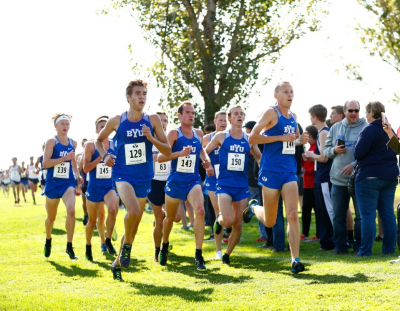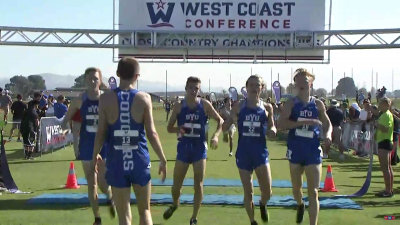This Is Not Your Older Brother’s BYU Team — The Cougars Are Ready for Their NCAA Moment
By Jonathan Gault
November 13, 2017
At Brigham Young University, missions are a rite of passage. Of the 33,363 students on the school’s Provo, Utah, campus last fall, 65 percent (including 88 percent of the male students) had served a mission for The Church of Jesus Christ of Latter-Day Saints. Those missions span the globe, from Paris to Tokyo to Bangkok, so compared to those locations, Louisville, Kentucky, doesn’t seem particularly glamorous. But on Saturday, Louisville will be the site of a mission of a different sort for seven BYU students: winning the school’s first NCAA cross country title.
For Ed Eyestone, a Utah native and the 1984 NCAA XC individual champ at BYU, this opportunity has been a long time coming. Eyestone, 56, has been the head coach at his alma mater since 2000, and during that span he’s coached athletes to NCAA titles in cross country, the mile, the steeplechase, and the distance medley relay. His teams have also piled up 13 conference titles and two NCAA podium (top 4) appearances in cross country. But during all these years, he’s never had a team like this one.
“I’ve had good teams in the past that have kind of looked at [their competition at NCAAs] and I think they feel like, Oh if somebody has an off day and we have a really great day, then we have a chance of being on the podium,” Eyestone said. “But this year I think is the first year where everyone goes, Uh, dang straight we belong on this podium and they’re gonna have to fight tooth and nail, any other team, to keep us from the top of the podium.”
A BYU win would also allow Eyestone to make some personal history: no man has ever won the NCAA cross country title and coached an NCAA title team.
So far, BYU has ripped through the 2017 season like a chainsaw through tissue paper. It began in earnest with the 17-point beating it laid on perennial powers Stanford and Oregon at the Dellinger Invitational on September 29, and continued with a 41-point performance at Pre-Nats two weeks later. Then, on October 27, the Cougars hung a perfect score of 15 on No. 3 Portland at the West Coast Conference meet, and though the Pilots held out some key athletes in that race, their top two runners from the Nuttycombe Wisconsin Invitational (Jeff Thies and Nick Hauger) did suit up.
Despite all that, BYU remains No. 2 in the coaches’ poll (#1 in the LetsRun.com Fan Poll) because defending national champion Northern Arizona has been just as good. Round one between the two schools at Friday’s Mountain Regional was the equivalent of two boxers circling the ring, with both teams content to qualify for NCAAs as easily as possible (NAU got the win officially, 49-79). Round two on Saturday will be a no-holds-barred affair and projects as one of the best team matchups in recent NCAA history.
Eyestone knows that the Lumberjacks are a formidable foe, but he’s excited for the challenge.
“I think it’s gonna be who has the best day,” Eyestone said. “It’s gonna be one of those 13-12 baseball games that you’re just hoping that your relief pitcher does better than their relief pitcher.”
BYU is led by the four-headed monster of juniors Rory Linkletter (13:49/28:58, 32nd NCAAs last year), Connor McMillan (13:53/29:15, 84th last year), and Clayton Young (13:45/28:45, 77th last year) and true freshman Casey Clinger (8:44 3200 in HS, 2 NXN titles), who, along with fifth man Daniel Carney (8:48 steeple/14:01, didn’t run ’16 NCAAs), have run together as if tied by a rope. BYU’s #1 through #5 spreads for its first four meets are scarcely believable for a team ranked No. 2 in the country: 4 seconds, 7 seconds, 17 seconds, 7 seconds.
Though they’ve had a tendency to blend into a wave of royal blue during races, each man offers something different. Linkletter is the most accomplished of the group: he was BYU’s top returner from NCAAs last year, finished as the NCAA 10,000-meter runner-up on the track, and has already represented Canada at the senior level at this year’s World Cross Country Championships in Uganda (he also won Pre-Nats in October). McMillan was the conference champ this year in cross country. Young has the fastest track PRs. Clinger was one of the greatest high school recruits of this decade, the only boy to win two NXN individual titles. Carney took a little longer to get up to speed this season after dealing with an injury this summer but finished right with BYU’s top group at WCCs.
 A sea of blue near the front has become a familiar sight in BYU’s races this year. Photo courtesy BYU Track and Field.
A sea of blue near the front has become a familiar sight in BYU’s races this year. Photo courtesy BYU Track and Field.
But just as amazing as the talent on the roster is where it comes from. Five of the team’s top seven at WCCs (which also includes senior Jonathan Harper (13:54/29:05, 101st at NCAAs) and sophomore Kramer Morton (14:28, two-time Foot Locker finalist) hail from within 35 miles of Provo (that includes Linkletter, who is Canadian by birth but went to Herriman High School in Utah). In fact, three of BYU’s top four — McMillan, Young, and Clinger — all went to the same high school: American Fork.
“Six of the seven are altitude kids, were either born at or raised at altitude, and you know, the Mountain Region is not perennially a contender by just luck,” Eyestone said. “I think the fact that much of our pool comes from the Intermountain area, where guys are either trained at altitude or at least have come from high school and have the ability to train at altitude, I think it helps.”
One particular location that the BYU men have been hitting hard this fall is a dirt road that runs along Deer Creek Reservoir, a 25-minute drive from campus. It’s a course that Eyestone’s top pupil, Olympic marathoner Jared Ward, ran during his New York City Marathon preparation, and the combination of the road’s dirt surface, rolling hills, and extra elevation (the reservoir is about 1,000 feet higher than Provo’s 4,500-foot elevation) has made it an ideal location to grind out long runs. And when they’re back on campus, the team has stayed closer to Ward in practice — a member of BYU’s last two podium teams — than ever before.
“This year has been the first year, it seems like, where occasionally I’ll run a workout with those guys and I’ll finish the workout and a few of them are right there with me,” said Ward, who finished sixth in last year’s Olympic marathon.
Okay, you might be thinking, this altitude stuff is great, but are you really going to write a story about BYU without mentioning the fact that the majority of their roster is two or more years older than their competitors?
I would mention that. If it were true, but it’s not. Here are the high school graduation years of BYU’s top seven finishers at conference:
- Connor McMillan, 2014
- Daniel Carney, 2012 (been on mission)
- Casey Clinger, 2017
- Rory Linkletter, 2014
- Clayton Young, 2012 (been on mission)
- Kramer Morton, 2014 (been on mission)
- Jonathan Harper, 2013
It’s important to acknowledge that BYU does have one of the oldest rosters in the NCAA: all but Clinger are in at least their fourth year post-high school. But only three runners in the top seven have been on missions and only two are older than a fifth-year senior. At most schools, Carney and Young, sixth-year seniors, would have already exhausted their eligibility. But because they went on missions — Carney to Sao Paulo, Young to Raleigh — each man remains eligible to compete (the NCAA allows student-athletes to serve religious missions without the time counting against their eligibility clock). In fact, both men are eligible to return next year as seventh-year seniors.
BYU is not the only team to rely on older athletes, however. Oklahoma State’s 2012 title team featured 23-year-old Shadrack Kipchirchir (the age of a sixth-year senior) and 24-year-old Girma Mecheso (the age of a seventh-year senior). Even this year’s NAU squad features 23-year-old Matt Baxter (the age of a sixth-year senior).
Does the fact that many BYU runners end their collegiate careers as 24- or 25-year-old sixth- or seventh-year seniors help? You bet, even though missionaries are only allowed to train on a very limited basis during their missions. There will be fans who dislike the mission exception (and by the way, there’s no rule that says only BYU athletes can serve missions), just as there are fans who dislike schools heavily reliant on transfers or foreign talent. The fact is, BYU isn’t doing anything illegal.
Brigham Young has enjoyed a storybook season so far, but of the 31 teams that line up on Saturday, only one gets the storybook ending. NAU is gunning for a repeat. Syracuse and Stanford have the top two runners in the country and are both coming off big conference victories. Portland went 1-2-4 at the West Regional and will also be vying for its first NCAA title. The final chapter in Louisville should be a thriller.




